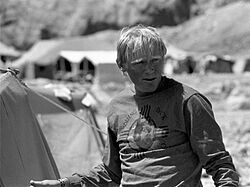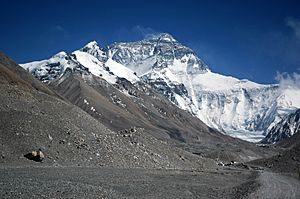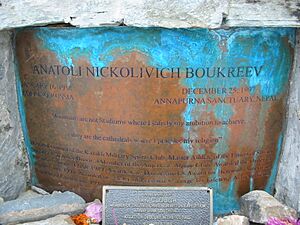Anatoli Boukreev facts for kids
Quick facts for kids
Anatoli Boukreev
|
|
|---|---|

Boukreev in 1991
|
|
| Born |
Anatoli Nikolaevich Boukreev
January 16, 1958 Korkino, Russian SFSR, USSR
|
| Died | December 25, 1997 (aged 39) |
| Cause of death | Avalanche |
| Citizenship | |
| Education | Bachelor of Science |
| Alma mater | Chelyabinsk State University |
| Occupation | Mountaineer |
| Known for | 18 ascents of 8000m peaks, 1996 Mount Everest disaster rescues |
| Awards | David A. Sowles Memorial Award |
Anatoli Nikolaevich Boukreev (Kazakh: Анато́лий Никола́евич Букре́ев; January 16, 1958 – December 25, 1997) was a famous Kazakh mountaineer. He was known for climbing some of the world's highest mountains. He successfully climbed 10 of the 14 peaks that are over 8,000 meters (about 26,247 feet) tall. He did this without using extra oxygen.
Between 1989 and 1997, Anatoli Boukreev reached the top of mountains over 8,000 meters 18 times. He was well-known among climbers for reaching the summit of K2 in 1993. He also climbed Mount Everest using the North Ridge route in 1995. He was also famous for climbing some of the highest mountains very quickly by himself.
Anatoli Boukreev became even more famous for saving climbers during the terrible 1996 Mount Everest disaster. Sadly, in 1997, he died in an avalanche while trying to climb Annapurna in Nepal during winter. His friend, Linda Wylie, later published his climbing stories in a book called Above the Clouds: The Diaries of a High-Altitude Mountaineer.
Contents
About Anatoli Boukreev
Anatoli Boukreev was born in Korkino, a town in the Soviet Union. His family was not wealthy. After finishing high school in 1975, he went to Chelyabinsk State University. There, he studied physics and also trained to be a cross-country skiing coach. He earned his degree in 1979.
After college, at age 21, Anatoli dreamed of climbing mountains. He moved to Alma-Ata, which was the capital of the Kazakh Soviet Socialist Republic (now Kazakhstan). This city is located near the Tian Shan mountains. From 1985, he joined a Kazakhstani mountaineering team. When the Soviet Union broke apart, he became a citizen of Kazakhstan in 1991.
In the 1990s, Boukreev worked as a professional mountain guide. He was guiding for Scott Fischer's company, Mountain Madness, during the 1996 Mount Everest disaster. He survived this event and played a key role in saving other climbers.
Amazing Climbs
Anatoli Boukreev achieved many incredible climbing feats. Here are some of his most notable climbs:
- 1987
- Lenin Peak (7,134 m) – He was the first to climb this mountain alone.
- 1989
- April 15 Kangchenjunga (8,586 m) – He found a new way up with the Second Soviet Himalaya Expedition.
- April 30 - May 2 Kangchenjunga – He was the first to cross all four 8,000 m peaks of this mountain range.
- 1990
- 1991
- May 10 Dhaulagiri – He found a new route on the west wall with the First Kazakhstan Himalaya Expedition.
- October 7 Mount Everest – He climbed the South Col route.
- 1993
- 1994
- April 29 Makalu II (8,460 m)
- May 15 Makalu (8,476 m) – He climbed with Neal Beidleman.
- 1995
- May 17 Mount Everest – He climbed the North Ridge route.
- June 30 Peak Abai (4,010 m) – He guided the President of Kazakhstan.
- October 8 Dhaulagiri (8,176 m) – He set a speed record, climbing it in 17 hours and 15 minutes.
- December 8 Manaslu (8,156 m) – He climbed with the Second Kazakhstan Himalaya Expedition.
- 1996
- May 10 Mount Everest – He climbed the South Col route.
- May 17 Lhotse – He climbed this mountain alone and set a speed record. He went from Base Camp to the top in 21 hours and 16 minutes without extra oxygen.
- September 25 Cho Oyu (8,201 m) – He climbed with the Third Kazakhstan Himalaya Expedition.
- October 9 North summit of Shishapangma (8,008 m)
- 1997
- April 24 Mount Everest (8,848 m) – He climbed the South Col Route as a guide.
- May 23 Lhotse (8,516 m)
- July 7 Broad Peak (8,047 m) – He climbed this mountain alone.
- July 14 Gasherbrum II (8,035 m) – He climbed this mountain alone.
Conquering Denali
In May 1990, Anatoli Boukreev was asked to guide climbers up Denali in Alaska. Denali, also known as Mount McKinley, is a very challenging mountain. It has hidden cracks in the ice and very cold, unpredictable weather. This is because it is close to the Arctic Circle and the ocean.
The expedition was a success. The team reached the top and returned safely. During the climb, Boukreev had to borrow some equipment. This made him feel a bit uncomfortable because he didn't have much money. After the team returned, Boukreev decided to try something amazing. He wanted to climb Denali alone and very quickly before going back home.
Boukreev's solo speed climb of Denali in 1990 was incredible. He went from the base to the top in just 10 and a half hours. Most climbers who were used to the mountain would take three to four days and five camps to reach the summit. Climbing magazine wrote about his achievement. Park rangers at Denali described his feat as "unreal."
The Challenge of K2
In 1993, Boukreev reached the top of K2. He climbed it using a route called the Abruzzi Spur. K2 is the second-highest mountain on Earth, after Mount Everest. It stands at 8,611 meters (about 28,251 feet) tall.
K2 is part of the Karakoram mountain range. It is located on the border between Pakistan and China. K2 is often called the "Savage Mountain." This is because it has very steep sides and is extremely dangerous to climb.
Boukreev faced a big danger on K2. He felt like reaching the top was the end of the climb. He later wrote that he didn't feel happy when he reached K2's peak. He was too tired, both physically and emotionally. He had used too much energy earlier that day. He had spent a lot of effort putting ropes along a narrow, steep part of the mountain.
The team wanted to push on to the summit that same afternoon. Boukreev agreed, even though it would have been safer to rest. He later wrote about the dangers of using all your energy to reach the top:
During my years of training as a ski racer, and then as a mountaineer, I had learned how to wring out the last of my energy for a finish. But this is dangerous in mountaineering, because the summit is not the finish of your competition with a great mountain. To survive you must be able to get down from the forbidden zone.
Boukreev described feeling like a "squeezed lemon." When he and two other climbers started to go down after sunset, they met another team member still climbing up. Boukreev used his experience and instincts to slowly make his way down the steep rock and ice. His crampon (a metal frame with spikes worn on boots) kept coming off. At one point, he had to use his ice axe to stop himself from falling into a deep hole. He finally made it to the tents at the highest camp. Sadly, two of his teammates never returned from the summit. They both fell to their deaths during the descent.
The Everest Disaster of 1996
Anatoli Boukreev became widely known for his role as a lead climbing guide during the 1996 Mount Everest disaster. He was part of the Mountain Madness expedition led by Scott Fischer. On May 10, 1996, several teams were trying to reach the top of Everest on the same day. Soon after they reached the summit, a terrible blizzard hit. Many climbers were stuck high on the mountain overnight. By May 11, eight climbers from different teams had died.
Boukreev showed incredible bravery. He rescued three climbers who were stranded above 8,000 meters (about 26,247 feet). All six of the clients from his Mountain Madness expedition survived the ordeal.

Galen Rowell, a famous photographer and climber, wrote about Boukreev's rescue efforts in the Wall Street Journal. He called it:
One of the most amazing rescues in mountaineering history performed single-handedly a few hours after climbing Everest without oxygen...
Anatoli Boukreev's Death
Just three weeks after receiving a special award called the David A. Sowles Memorial Award, Boukreev began a new climb. He planned to climb the south face of Annapurna I (8,091 m or about 26,545 feet). He was with Simone Moro, a skilled Italian mountaineer, and Dimitri Sobolev, a filmmaker from Kazakhstan. Sobolev was filming their climb.
On December 25, 1997, around noon, Boukreev and Moro were setting up ropes. They were in a narrow gully (a couloir) at about 5,700 meters (about 18,700 feet). Suddenly, a huge piece of ice and snow, called a cornice, broke off from high up on Annapurna's Western Wall. It crashed down the 800-meter (about 2,625 feet) long gully.
The avalanche swept Moro down the mountain. He landed just above their tent at Camp I, which was at 5,200 meters (about 17,060 feet). Luckily, Moro stayed near the top of the avalanche debris. He managed to dig himself out after a few minutes. He could not see or hear Boukreev or Sobolev. Moro had seen Sobolev disappear under "car-sized blocks of ice." Moro then went down to Annapurna base camp. From there, he was flown by helicopter to Kathmandu for surgery on his hands. His hands were badly injured during the fall.

News of the accident reached New Mexico on December 26. Linda Wylie, Boukreev's girlfriend, flew to Nepal on December 28. Several attempts were made to reach the avalanche site by helicopter. However, bad weather in late December stopped search teams from reaching Camp I. On January 3, 1998, searchers finally reached Camp I. They found an empty tent. Linda Wylie then made a sad statement from Kathmandu:
This is the end... there are no hopes of finding him alive.
Nine months before he died, Boukreev had a very detailed dream about dying in an avalanche. The only thing missing from his dream was the name of the mountain. When his girlfriend tried to convince him to choose a different path in life, he replied, "Mountains are my life...my work. It is too late for me to take up another road."
Memorial
At the Annapurna base camp, there is a memorial stone (a chorten) for Boukreev. It includes one of his favorite quotes:
"Mountains are not stadiums where I satisfy my ambition to achieve, they are the cathedrals where I practice my religion."
On January 18, 2023, a sculpture of Boukreev was revealed at the Medeu ice sports rink. The sculpture, made by Nurlan Dalbai, shows the mountaineer resting with his hand on an ice axe.
See also
 In Spanish: Anatoli Bukréyev para niños
In Spanish: Anatoli Bukréyev para niños
- List of climbers
- List of Mount Everest summiters by number of times to the summit



